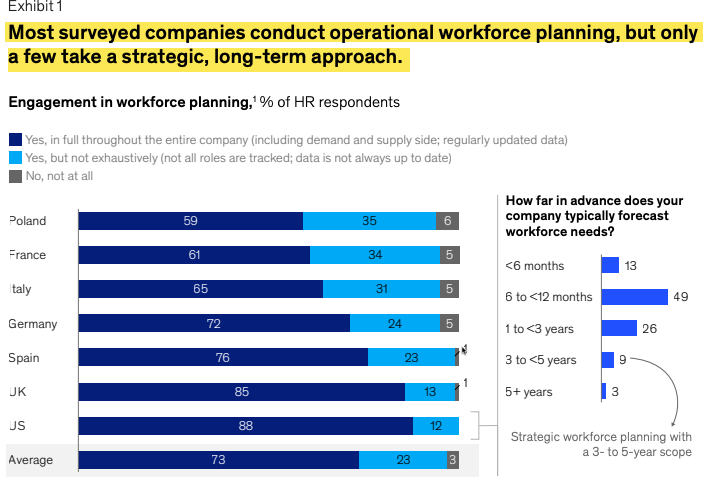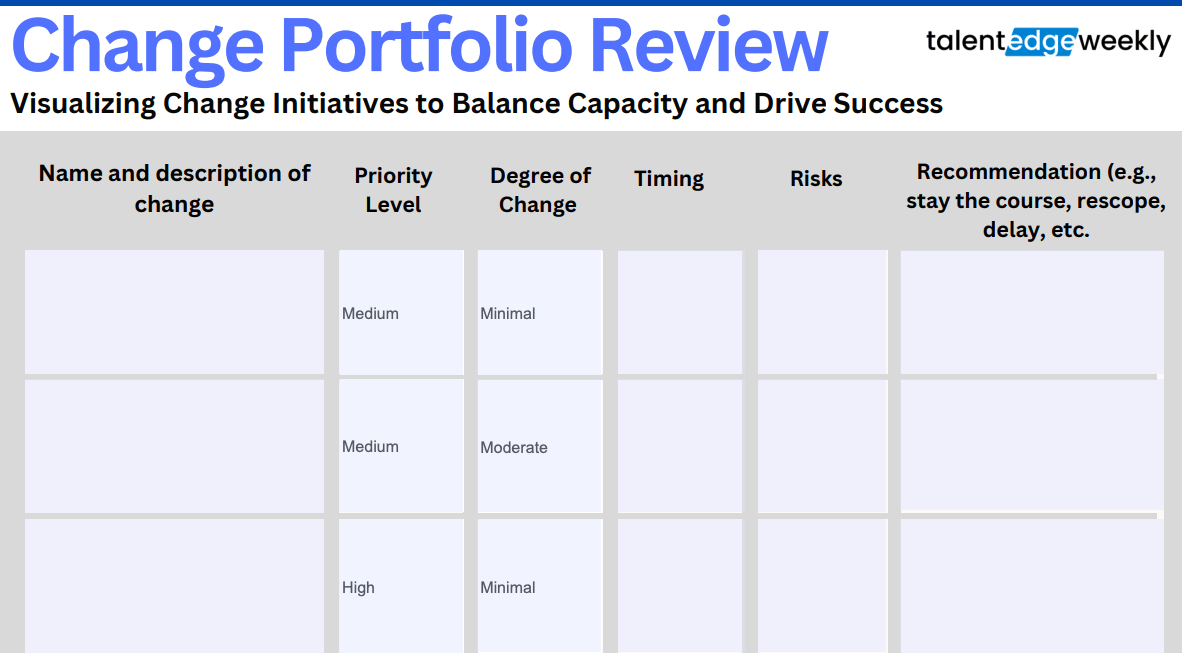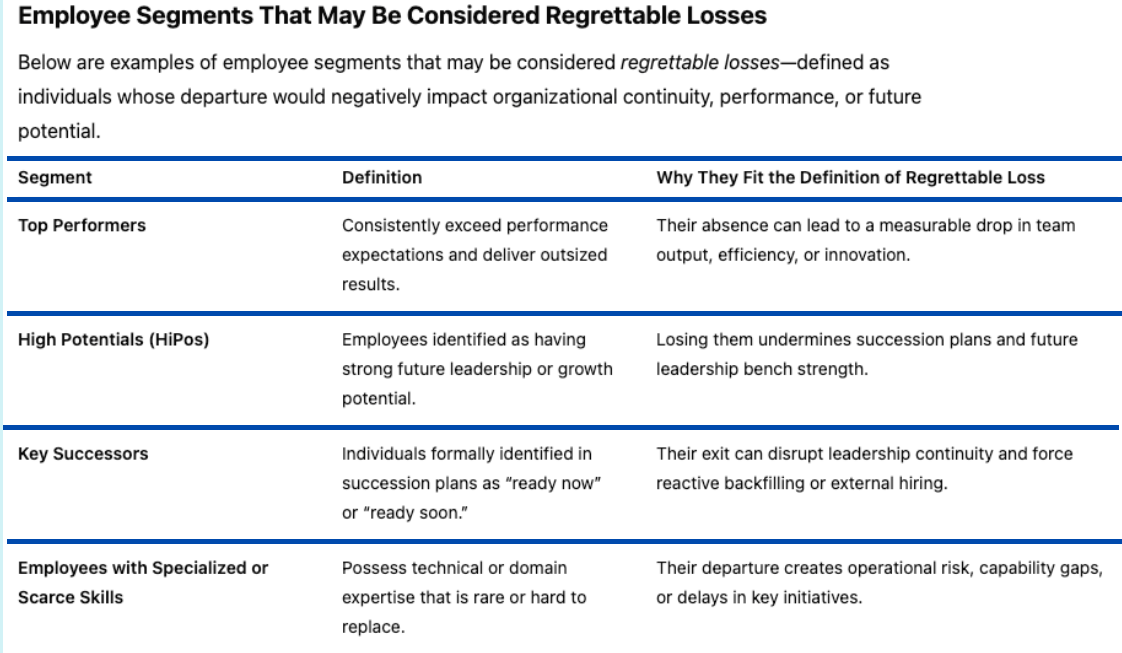- Talent Edge Weekly
- Posts
- Talent Edge Weekly - Issue #308 - Best of July 2025
Talent Edge Weekly - Issue #308 - Best of July 2025
Here are the most popular articles and resources from the July issues of Talent Edge Weekly. An abridged version is also available.
Welcome to this special Best of July issue of Talent Edge Weekly!
First, a shout-out to Hilary Eigelshoven, Director, Human Resources at Canada Guaranty, for referring new subscribers to Talent Edge Weekly. Thank you, Hilary, for your support of this newsletter!
PRESENTED BY Draup
As organizations pivot toward skills-based strategies in workforce planning, hiring, and internal mobility, the missing link remains a scalable, intelligent skills architecture—one that goes beyond surface-level role definitions.
Draup’s AI-powered Skills Architecture addresses this need head-on. It breaks down roles into root skills, core competencies, and associated tech stacks.
Built on over 850 million job descriptions, 50k products in Tech Stack ,and a taxonomy of 17,500+ curated skills, our model allows organizations to:
Surface hidden capability gaps across business units
Anticipate the next wave of skill evolution
Orchestrate targeted, skill-first talent interventions
If your organization is serious about embedding a skills-based approach at scale, download Draup’s Skills Architecture report to see what’s possible.
Want to get your brand, product, or service in front of 53,000+ Talent Edge Weekly subscribers? Learn how to become a potential sponsor.
THIS MONTH’S CONTENT
This Best of July issue includes 17 of the most popular resources from July.
The resources are organized into four sections:
Workforce Planning & Scenario Planning. Highlights how organizations can strengthen workforce planning by integrating scenario planning to anticipate and prepare for future talent needs.
Succession, Leadership, & Organizational Change. Features tools and research focused on succession planning, leadership behaviors, and managing the cumulative toll of organizational change.
Talent & Performance Enablement. Provides tools, frameworks, and practices to help organizations drive performance, retain key talent, enable skills-based talent practices, and rehire talented former employees.
AI in the Workplace. Covers how AI—particularly GenAI and AI agents—is reshaping workplace dynamics, from performance management and hiring to team collaboration and work design.
This issue has many bonus resources beyond the 17 featured resources.
You can also view an abridged version, which just includes links.
Let’s dive in.
THIS MONTH’S EDGE
I. Workforce Planning & Scenario Planning
Highlights how organizations can strengthen workforce planning by integrating scenario planning to anticipate and prepare for future talent needs

WORKFORCE PLANNING
My cheat sheet with questions to help HR and business leaders align workforce plans with potential business scenarios.
Many organizations still approach strategic workforce planning (SWP) as a static, annual exercise—often based on a single, expected scenario. However, as business needs and conditions shift rapidly, SWP requires a more dynamic and flexible approach. Scenario planning (SP) enables organizations to explore and prepare for a range of possible futures, helping them respond more effectively to uncertainty. If you've ever planned a vacation with a backup plan in case of bad weather, you've used SP—thinking ahead, identifying alternatives, and adapting as conditions change. Or consider a sports team preparing for a championship game. They don’t rely on one game plan—they prepare for what to do if other scenarios unfold: a star player gets injured, the opponent changes strategy, the game clock is running out, or weather impacts play. The same principle applies in business. SP helps leaders prepare for various scenarios. These scenarios then guide SWP, where talent implications are outlined and specific responses developed. Although SP varies in sophistication—often enabled by technology and analytics—simply discussing scenarios and possible responses is a valuable starting point. To help connect business scenarios with SWP, my cheat sheet includes a set of questions to guide your planning.

SCENARIO PLANNING
Offers guidance to conduct more effective scenario planning—a critical capability for both business and workforce planning.
As many practitioners continue to build scenario planning (SP) capabilities to integrate within their workforce planning, this new article reinforces the value of SP and offers insights on constructing more expansive and plausible business scenarios. One point mentioned: beware of overindexing on short-term signals when developing and planning for possible futures. In uncertain times, leaders may overreact to headlines or social media posts, treating them as definitive indicators when they may be temporary or incomplete. Instead, leaders should view new developments as one data point in a broader pattern, revising assumptions based on emerging evidence, a method known as Bayesian updating. To support scenario planning, I’m also sharing a new report by the World Economic Forum, Four Scenarios for the Future of Travel and Tourism. While industry-specific, it provides useful insights and examples for constructing effective scenarios. Question: Can you explain—at least directionally—how your workforce planning and supporting tactics (e.g., buy, build, borrow, bot, etc.) would need to shift under different business scenarios? If not, now is a great time to begin.

WORKFORCE PLANNING
A 34-page report with benchmarks across multiple areas of HR, including workforce planning.
In this 34-page report, survey benchmarks and HR trends across Europe are shared across six key areas: aligning people, strategy, and technology in times of change; strategic workforce planning (SWP); talent acquisition; employee development; employee experience; and transforming HR service centers and operating models. The report presents a framework outlining three types of workforce planning: 1) operational workforce planning, which focuses on short-term staffing needs and forecasts approximately one year ahead; 2) strategic workforce planning, which projects staffing needs over a three-to-five-year horizon aligned with business strategy and scenario planning; and 3) skills-based SWP, which emphasizes identifying, developing, and deploying critical skills across varying time frames rather than focusing solely on headcount and job roles. While most organizations engage in operational workforce planning, only a small percentage practice long-term SWP—for example, just 12% of U.S. organizations do so. As I noted in my 2019 People + Strategy article, integrating both roles and skills into workforce planning is vital for making SWP truly effective. And in my April 2024 chapter for the Society for Industrial and Organizational Psychology (SIOP) Professional Practice Series book, Strategic Workforce Planning: Best Practices and Emerging Directions, I share results from a pilot study on how AI-driven platforms can enable more effective workforce planning—both in the short and long term.
II. Succession, Leadership, & Organizational Change
Features tools and research focused on succession planning, leadership behaviors, and managing the cumulative toll of organizational change.

SUCCESSION PLANNING
A 25-page report offering practical insights on how CHROs can play a pivotal role in helping boards overcome key challenges in CEO succession.
This 25-page report outlines 10 common challenges boards face in CEO succession—and how a trusted Chief HR Officer (CHRO) can help address them. Based on interviews with directors, investors, and succession experts, as well as a national survey of corporate directors, the report provides practical suggestions for addressing each challenge. While there are too many insights to summarize here, two challenges stand out: Challenge 5: Lack of Depth in Succession Discussions. Only 35% of directors believe their board has sufficient time for CEO succession planning, and just 26% of those prioritizing it feel confident in the amount of time available for in-depth discussions. Even when emergency succession plans exist, they’re often outdated or untested. Strong boards invest in both emergency and long-term plans to ensure their viability and relevance. Challenge 6: Limited Insight into Internal Talent. Many boards lack direct exposure to internal CEO candidates and rely on information that may be filtered or incomplete. CHROs can help by providing objective insights into internal candidates, creating structured ways for directors to engage with emerging leaders, and aligning objective assessment tools with future leadership needs. Although the report focuses on CEO succession, many of the insights can be applied to succession planning at levels below the CEO.

SUCCESSION PLANNING
My one-page cheat sheet helps practitioners explore succession planning (SP) from four angles to support a more deliberate approach to SP.
Succession planning (SP) remains a top priority for many organizations. In response to frequent requests for SP resources, I’ve created a one-page cheat sheet that consolidates elements from several of the individual cheat sheets I’ve previously shared on the topic. This cheat sheet includes four components: 1) SP Questions – A set of 10 questions to help organizations clarify their approach, such as determining the scope of succession planning (what roles they will focus on) and how they will assess successor readiness to assume a targeted role; 2) SP Metrics – A list of 12 metrics, including the percentage of non-ready-now successors with a development plan and the success rate of successors after assuming the role; 3) Trigger Events for Reassessment – Nine examples of events that may warrant a reassessment of succession plans, such as shifts in business strategy, organizational transformation, or successor turnover; and 4) High-Impact Development Role Audit – Four starter questions to help determine when it may be time to move someone out of a high-impact development role—particularly when their continued presence limits opportunities for others in the pipeline. This cheat sheet is designed to help practitioners take a more deliberate approach to succession planning, ensuring that plans remain relevant and actionable.

LEADERSHIP
New research (not yet peer-reviewed) explores the hidden organizational costs of ineffective leadership—ranging from direct financial losses to cultural impacts.
A new (yet-to-be peer-reviewed) study introduces the concept of the "Total Cost of Difficult Leaders" (TCDL) to estimate the full organizational burden of ineffective leadership behaviors. Using a mixed-methods approach and data gathered from 42 organizations over a 12-year span (2011–2023), the researchers quantified how problematic leaders affect company performance across three dimensions: 1) direct financial costs such as turnover, absenteeism, and legal risk; 2) operational costs including lower innovation, poor decision-making, and weakened collaboration; and 3) cultural costs related to toxic behavior modeling, loss of trust, and reputational harm. The longitudinal findings suggest that a single underperforming leader can cost an organization anywhere from 1.75 to over 10 times their salary annually, with an average impact of 8.7 times compensation (SD = 4.3) for mid-level leaders. While the authors offer practical suggestions for identifying and addressing these risks, they also caution that broader application may be limited by contextual differences, cultural variability, and the challenge of proving causality. The appendix includes several resources, such as the full leadership survey used in the study, interview questions for direct reports about their leaders, and exit interview prompts related to leadership experiences.

CHANGE MANAGEMENT
My one-page template to help leaders assess current and proposed organizational changes to manage change fatigue better and ensure sustainable implementation.
As many organizations implement workplace changes, such as new technologies, AI, team restructuring, return-to-office policies, or updated processes, I’ve received multiple requests for change management resources. Behind these requests is a growing concern about change fatigue: a state of physical and mental exhaustion caused by the constant need to adapt to new initiatives. According to Prosci’s Best Practices in Change Management report (May 2023), the average organization manages five major change initiatives at any given time, with many overseeing 10 or more when including smaller projects and process changes. That number is likely even higher today. Leaders who focus solely on the business case for individual change initiatives often lack visibility into the overall volume of change occurring across the organization. This can lead to a cumulative toll on teams—driving disengagement, resistance, and burnout. To help leaders gain a clearer view and manage change in a more sustainable manner, my one-page template helps initiate a holistic review of all current and proposed changes, their timing, and their impact across various groups. This editable one-pager helps organizations better align the pace of change with employees’ capacity to adapt, serving as a starting point for developing more detailed change management plans.
III. Talent & Performance Enablement
Provides tools, frameworks, and practices to help organizations drive performance, retain key talent, enable skills-based talent practices, and rehire talented former employees.

ORGANIZATIONAL EFFECTIVENESS
My template to help identify opportunities to redeploy resources—talent and financial— to high-priority areas.
Now that we’re well into the second half of 2025, it’s a good time for managers, leaders, and individual contributors to revisit their goals and consider how to accelerate progress for the remainder of the year. A few weeks ago, I shared my one-page infographic outlining practical actions that each of these employee segments can take to realign and drive momentum on 2025 objectives. One key action for leaders, managers, and others responsible for managing resources—such as budget or talent—is ensuring those resources are effectively allocated to the most critical priorities. To help, my one-page worksheet enables leaders to evaluate key factors for resource deployment by: 1) listing ongoing projects or initiatives, 2) prioritizing them based on stakeholder value and strategic alignment, 3) tracking status (e.g., on track, behind, completed), 4) noting budget utilization (e.g., $25K used of a $100K budget = 25%), and 5) assessing talent deployment (e.g., 3 of 4 team members utilized = 75% utilization). This information supports better resource decisions and can help optimize performance in the months ahead. While the tool is simple, it can prompt valuable conversations that lead to more impactful outcomes.

DEVELOPMENT & PERFORMANCE
My cheat sheet includes examples of workplace ‘blind spot’ scenarios and tactics to identify and mitigate them.
A few weeks ago, while backing my car out of a tight spot in a mall parking garage, I checked my mirrors and thought I had a clear view. But just as I began to move, someone walked behind my car. Fortunately, my vehicle’s safety system alerted me in time. It was a reminder of how easily we can overlook something nearby, often very close, simply because we’re unaware it’s there, even when we think we’re paying attention. The same thing happens in organizations, where we can miss critical issues or behaviors that are right in front of us because they fall outside our awareness. In the workplace, blind spots are gaps in self-awareness that can undermine performance, relationships, or career growth if not recognized and addressed early. These blind spots vary by context, such as being a first-time manager, shifting from an operational to a strategic role, or returning to a role after a career break. To help, I’ve created a one-page cheat sheet with nine example scenarios where blind spots often emerge, early warning signs they may be present, and a sample tactic to help address each. As you review the cheat sheet, consider asking a colleague, a boss, or a direct report: “What’s one thing you think I’m unaware of in how I work or lead that, if improved, could significantly impact my own performance as well as that of the team and people with whom I work?” The answer may uncover a hidden opportunity to accelerate your growth, fuel team performance, and create stakeholder value.

PERFORMANCE MANAGEMENT
My one-page cheat sheet to unlock opportunities for getting more value from 1:1 performance check-in discussions.
One of the most overlooked components of effective performance management (PM) is the quality of regular 1:1 discussions between managers and their direct reports. While technology, processes, and tools are important enablers, they can’t compensate for the gaps caused by ineffective conversations. It’s these discussions that clarify priorities, remove roadblocks, and build momentum. Even small missed opportunities in 1:1s can quietly compound over time and undermine performance. To help, my one-page cheat sheet includes eight key areas, each with a reflection question for managers and their direct reports. For each area, there’s a brief note on why it matters and a practical tactic to improve it. A few questions include: Are your 1:1s consistently happening, or do they get skipped? Are you focusing on what matters most—performance, priorities, and development? Have you discussed whether your cadence and format still work? Do you leave with clear next steps? While the fundamentals of PM may not feel exciting, executing them consistently and effectively often makes the biggest difference. Even experienced leaders may have untapped opportunities to elevate their 1:1s. Use the cheat sheet to spark a candid discussion and drive stronger performance outcomes in the months ahead.

SKILLS-BASED TALENT PRACTICES
A 35-minute presentation by Ravin Jesuthasan at the 2025 Wharton People Analytics Conference explores how organizations can adopt skills-based talent practices.
As organizations implement skills-based talent practices, many are reimagining how work is structured—shifting from rigid job titles to more flexible, skills-powered approaches. In this 35-minute session from the 2025 Wharton People Analytics Conference, future of work expert and The Skills-Powered Organization: The Journey to the Next-Generation Enterprise co-author Ravin Jesuthasan shares research-based insights, actionable frameworks, and real-world case studies. While there are too many insights to fully capture here, around the 12-minute mark, he introduces four core principles of the new skills-based operating system: 1) start with the work—focusing on current and future tasks rather than predefined jobs; 2) achieve the optimal combination of humans and automation; 3) consider the full array of human work engagements—including employment, gig, freelance, alliances, and project-based work; and 4) allow talent to flow to work, rather than being limited to fixed, traditional roles. He shares practical ideas for how applying these principles can help organizations build more dynamic talent models, unlock workforce potential, and drive stronger performance in a rapidly evolving environment.

EMPLOYEE RETENTION
Employee Retention: Are You Proactively Identifying and Managing “Regrettable Losses?” | Brian Heger
My cheat sheet includes 10 examples of employee segments that may be considered regrettable losses—employees whose departure would negatively impact the organization.
Most would agree that managing employee retention and turnover is a critical aspect of effective talent management. While some level of turnover is both healthy and necessary, certain types of departures can have a significantly negative impact. These exits—commonly referred to as "regrettable losses"—often involve individuals whose absence disrupts key outcomes such as business performance and the achievement of organizational priorities. Although many organizations focus on retaining high-potential talent or employees who are deemed successors, regrettable turnover can also occur in less obvious segments, such as Culture Carriers (those who embody and reinforce the organization’s values and behaviors), individuals with rare cross-functional expertise, or informal team leaders. To mitigate this risk, organizations should define what constitutes a regrettable loss in their specific context and proactively identify and address retention risks across these employee segments, not just the most obvious ones. To support this effort, my cheat sheet highlights 10 examples of employee segments that may be considered regrettable losses. Building awareness of these segments is a critical first step toward mitigating undesirable retention risks.

TALENT ACQUISITION
My cheat sheet for evaluating when rehiring a former employee might provide a talent advantage.
Rehiring former employees can be a powerful talent strategy that gives organizations a distinct advantage. A study in the Academy of Management Journal found that rehires often outperform new hires in roles requiring collaboration and strong internal networks, as their organizational knowledge enables them to ramp up quickly and bridge communication gaps. Similarly, research in Organization Science highlights that returning employees tend to help both new and existing colleagues more than external hires. Still, not every rehire is the right move. Hiring managers should take a thoughtful, strategic approach—considering both (1) the organization’s current needs and (2) the former employee’s fit with today’s context, culture, and priorities. When these factors align, rehiring can offer more than just a faster ramp-up—it can accelerate performance and unlock meaningful value. To support these decisions, my quick cheat sheet helps leaders assess key considerations across both categories. As a bonus insight, an analysis by Visier found that the average time away for returning employees is 13 months (but can be up to 36 months)—and the chances of return drop sharply after 16 months, making that window a critical period for rehiring.
IV. AI in the Workplace
Covers how AI—particularly GenAI and AI agents—is reshaping workplace dynamics, from performance management and hiring to team collaboration and work design.

AI IN THE WORKPLACE
Explores how AI agents could shape the future of work through the illustrated experiences of three workforce personas.
This article explores what an AI-enabled workforce could look like through the lens of three personas: a new hire (Riley), a VP (Taylor), and a CEO (Angelina). Each example illustrates how AI agents—drawing on personal data, behavioral signals, and business context—can enhance how people onboard, lead, and make strategic decisions. Riley’s agent is tailored to her communication style and career goals based on prehire assessments. It guides her through onboarding, answers follow-up questions, introduces mentors, books a social lunch, and even detects elevated heart rate before a key meeting—offering real-time coaching to help her feel confident. Taylor’s agent helps optimize daily work by surfacing project updates, adjusting his calendar, preparing him for a CEO presentation via a VR simulation, and even setting meeting agendas that include icebreakers based on team feedback. At the executive level, Angelina’s agent aggregates real-time internal and external data to support complex decision-making, facilitates strategic planning, and coaches her through town hall rehearsals using biofeedback and simulated audience reactions. As the article notes, “While the scenarios above may seem like something from a science-fiction novel, the reality is that this technology already exists.” One practical takeaway is that organizations can begin exploring how AI agents might be applied across different workforce personas—helping to evaluate where these technologies could have the greatest impact and create stakeholder value.

AI AND SELECTION
Shares results from a study on how AI-based hiring assessments can unintentionally influence candidate behavior.
The use of AI across various talent practices continues to present powerful opportunities. I recently shared my infographic, which features 12 AI-in-HR use cases, each paired with a benefit, potential risk, and mitigation tactic. The goal: help HR teams explore how AI can solve business problems while managing unintended consequences. A new HBR article reinforces this need for thoughtful use. In a study of over 13,000 participants across 12 lab and field studies, researchers found that when candidates knew they were being assessed by AI during the hiring process, they emphasized analytical traits and downplayed qualities such as empathy, creativity, and intuition. This behavior can lead to a more uniform candidate pool and reduce assessment accuracy. To address this, the authors recommend: 1) clearly explaining what traits the AI is evaluating—including non-analytical ones like emotional intelligence and creativity, 2) regularly checking for patterns that show candidates are presenting themselves in similar ways, and 3) combining AI assessments with trained human reviewers who can recognize and counteract these effects. Aside from the HBR article, there’s also the academic paper on which the article is based. As a bonus, I’m re-sharing a 36-page paper from the Society for Industrial and Organizational Psychology (SIOP), which offers recommendations for validating and utilizing AI-based assessments in employee selection.

AI AND PERFORMANCE MANAGEMENT
Covers how AI might help organizations address common pain points associated with performance management.
AI continues to show promise in enhancing various talent and HR practices. As such, I previously shared my one-page cheat sheet with 12 AI-in-HR use cases to help teams generate ideas. One area gaining particular interest is performance management (PM), where AI can support goal setting, reviews, and feedback. However, as highlighted in a recent Gartner article, adoption remains limited, often due to compliance concerns and unclear ROI. While the article offers several insights, including a case study on how Thrivent is utilizing AI, Table 1 may be particularly useful. It maps specific PM pain points to GenAI capabilities, helping teams start with the problem they’re trying to solve rather than with a use case. For example, one common pain point is unclear or biased feedback. GenAI capabilities, such as writing assistants, can enhance clarity, tone, and word choice while minimizing bias. Another pain point is the quality or delivery of feedback, where GenAI can support managers through digital coaching tools or private GenAI chat assistants—helping them build the skills needed for more effective and candid conversations. Practitioners can use this type of framework as a starting point to identify opportunities for leveraging AI within performance management. They can also refer to my cheat sheet, which highlights the importance of identifying the risks associated with each use case and developing strategies to mitigate them.

AI AGENTS
Recently published resources on AI agents in the workplace—beginning with broad trends and moving into practical applications, workforce implications, and scientific research.
As AI agents evolve from passive tools to active collaborators, they’re reshaping how work gets done, who does it, and how teams are structured. Here are five recently published resources on the topic. 1) AI at Work: How Human-Agent Teams Will Reshape Your Workforce. Microsoft Worklab offers a comprehensive overview of how AI agents are evolving into digital collaborators. Covers implications for workforce planning, the human-to-agent ratio, role redesign, and employee reskilling. 2) Agentic AI Is Already Changing the Workforce. A Harvard Business Review article examines how AI agents are evolving from support tools to digital teammates, outlining seven key actions for integrating them into hybrid teams. 3) Seizing the Agentic AI Advantage. McKinsey dives into how agentic AI can deliver measurable value by executing end-to-end workflows. Includes a case study of a retail bank using AI agents to cut credit memo turnaround time by 30%. 4) A Day in the Life of an AI-Enabled Workforce. Deloitte utilizes three personas (new hire, VP, and CEO) to demonstrate how AI agents can personalize onboarding, optimize leadership workflows, and support strategic decision-making. 5) Collaborating with AI Agents: Field Experiments on Teamwork, Productivity, and Performance. Massachusetts Institute of Technology (MIT) presents research demonstrating how human-AI teams outperform human-only teams in terms of productivity and quality. Highlights how personality traits influence the outcomes of collaboration.
JOB CUTS AND LAYOFF TRACKER
Here is my tracker, which includes announcements from a segment of organizations that have announced job cuts and layoffs since the start of 2023.
A few firms that announced job cuts in July include:
4D Molecular Therapeutics (NASDAQ: FDMT). The late-stage biotechnology company announced a 25% reduction in its workforce, encompassing both current and planned roles. Impacted employees primarily work in areas supporting early-stage research and development, as well as support functions.
Indeed and Glassdoor. Recruit Holdings, the parent of Indeed and Glassdoor, will reduce headcount by around 1,300 across the two job sites amid a shift in focus toward AI. The cuts — representing about 6% of the HR tech segment workforce — are mostly in the U.S. and within the R&D, growth, and people and sustainability teams, but span all functions and several countries.
Intel (NASDAQ: INTC). The semiconductor giant plans to cut over 5,500 jobs globally in its latest round of layoffs. The cuts will impact engineers, senior staff, and back-office staff. The latest job cuts follow Intel's earlier layoff of 15,000 workers this year.
Shiseido (OTCMKTS: SSDOY). The Japanese beauty giant has initiated layoffs at its U.S. unit. While the company hasn’t confirmed if other regions will be affected, internal communications mention “a significant reduction in headcount across multiple businesses, functions, and locations.”
Walmart (NYSE: WMT). The U.S.-based retail giant is eliminating jobs in its corporate workforce, affecting hundreds of roles in store support and training. The company is eliminating market coordinator positions and coach roles at Walmart Academy to streamline operations and minimize friction for store associates.
CHIEF HR OFFICER MOVEMENT
62 Chief HR Officers were hired, promoted, and/or resigned in July. A few headlines include:
Franklin Electric Co., Inc. (FORT WAYNE, INDIANA) [NASDAQ: FELE]—a global manufacturer and distributor of systems and technologies for moving and protecting the world's most critical resources: water, fuel, and electricity—announced the appointment of Daniela Williams as Chief Human Resources Officer. She joins from Visteon Corporation, where she served as VP People and Culture.
Johnson Controls (CORK, IRELAND) [NYSE: JCI]—a global leader for smart, healthy and sustainable buildings—announced the appointment of Chris Scalia as EVP, Chief Human Resources Officer. Scalia joins Johnson Controls after spending two decades at The Hershey Company, where he most recently served in dual roles as Chief Human Resources Officer and Chief Transformation Officer.
Shake Shack Inc. (NEW YORK) [NYSE: SHAK]—an American multinational fast casual restaurant chain— announced the appointment of Jamie Griffin as Chief People Officer. Griffin most recently served as founder of the strategic advisory firm Consult to Grow®. Before that, he served as the SVP of Business Administration (Strategy, HR, Risk, and Legal) at Raising Cane’s Chicken Fingers.
Vimeo, Inc. (NEW YORK) [NASDAQ: VMEO]— the largest and most trusted private video network in the world— announced the appointment of Rose Frawley as its Chief People Officer. Most recently, Rose served as Chief People Officer at YipitData. Prior to YipitData, she was the Chief People Officer at Vivvix.
Never miss another CHRO announcement. Subscribe to my CHROs on the Go subscription and gain immediate access to +4000 (and growing) CHRO announcements, including hires, promotions, resignations, and board appointments.
If you are already a subscriber to CHROs on the Go, log in here.
I look forward to sharing more resources with you throughout August.
Have a great month ahead, and I’ll see you in next week’s issue!
Talent Edge Weekly is written by Brian Heger, a human resources practitioner. You can connect with Brian on Linkedin and brianheger.com.



















